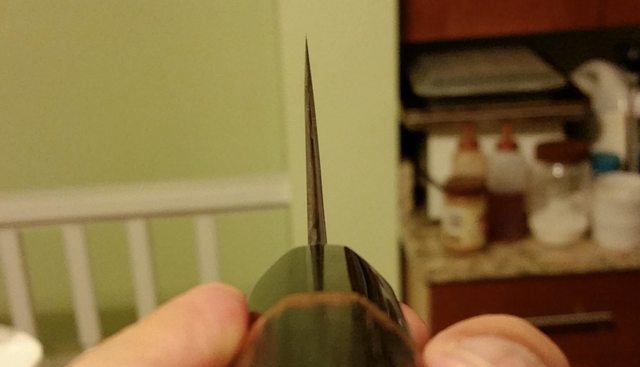When I first got into Japanese knives I was impressed because they were much lighter and more nimble than the German knives I was used to. And I liked the fact that they were made of a hard steel that was easy to sharpen and that I could get to a screamy edge.
But nowadays there is another type of Japanese knife that is quite popular: the workhorse knife. By a workhorse I mean a knife that is quite hefty (for a Japanese knife) and relatively thick at the spine.
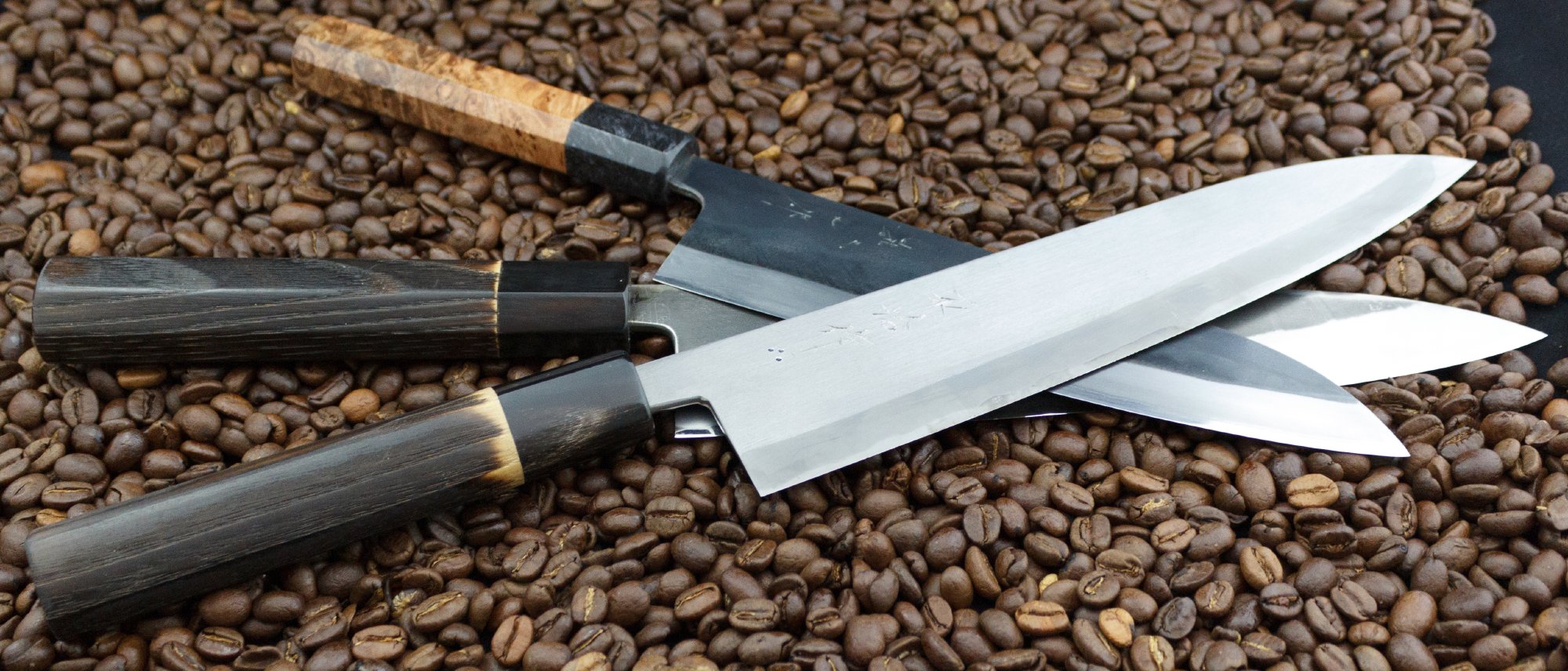
So I decided to get a number of workhorse knives and to see how I liked them: a 210 mm Nakaya-Heiji gyuto, a 180 mm Watanabe gyuto and a 210 mm Kochi gyuto.
Looks
All three of the knives have what I would call a rustic look. The Kochi and the Watanabe have a kurouchi finish and the Heiji is also a cladded knife. The core steel of the Heiji is a semi-stainless steel, the core of the Kochi is an unspecified carbon steel and the Watanabe is made of aogami steel. The claddings on all three of the knives are stainless. Funnily enough, the Heiji was the first one to pick up a patina, even though it was the only one made of semi-stainless steel. None of the knives are very reactive, by the way.
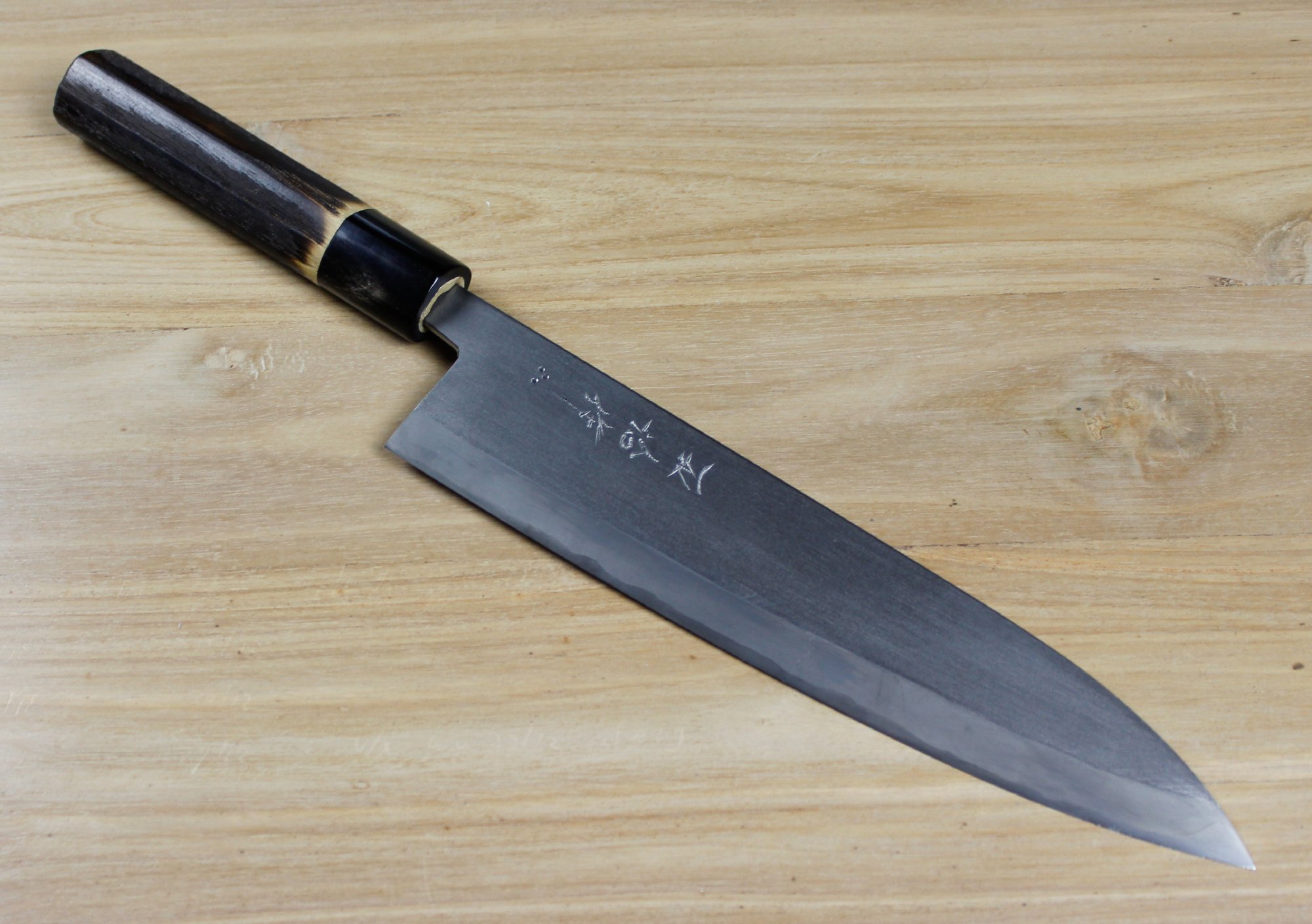
Heiji
Rustic sometimes also means that the fit and finish are not optimal. All three of the knives had handles made of burnt chestwood, but the handle of the Watanabe was badly finished: there was at least a millimeter difference in height between the wood and the ferrule. And the ferrule was made of plastic. So I decided to replace that handle by a nice one made of Oregon maple burl. There were no sharp edges on any of the knife spines, but the Kochi was the only one with a rounded spine and ferrule. It was clearly the best finished knife.
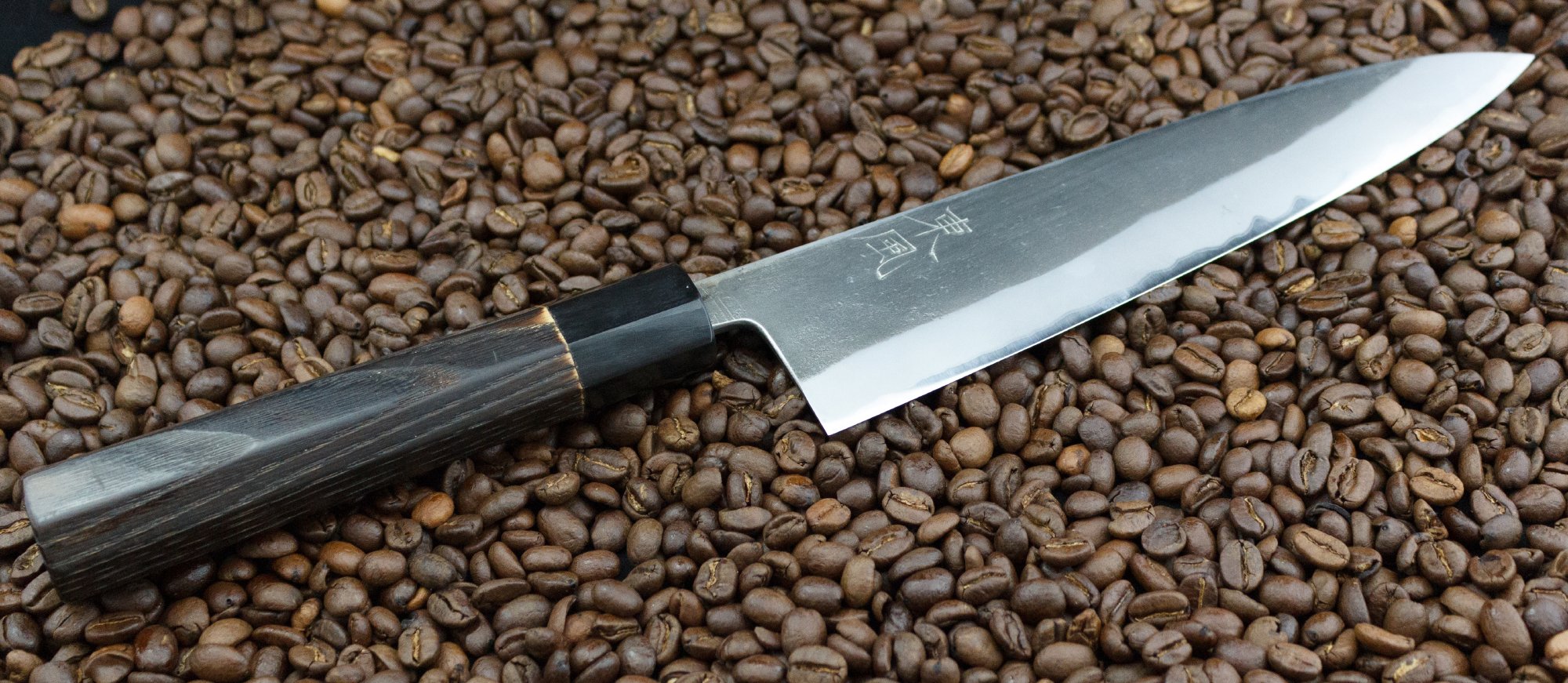
Kochi
All three knives came pretty sharp out of their boxes, only the Heiji had a wire burr. So I first took that one to a fine stone. Even though I hardly sharpened it, I immediately felt I liked the steel: it gave a very good feedback. And I'm sure that if I'd sharpen it further, that would be an easy and enjoyable task.
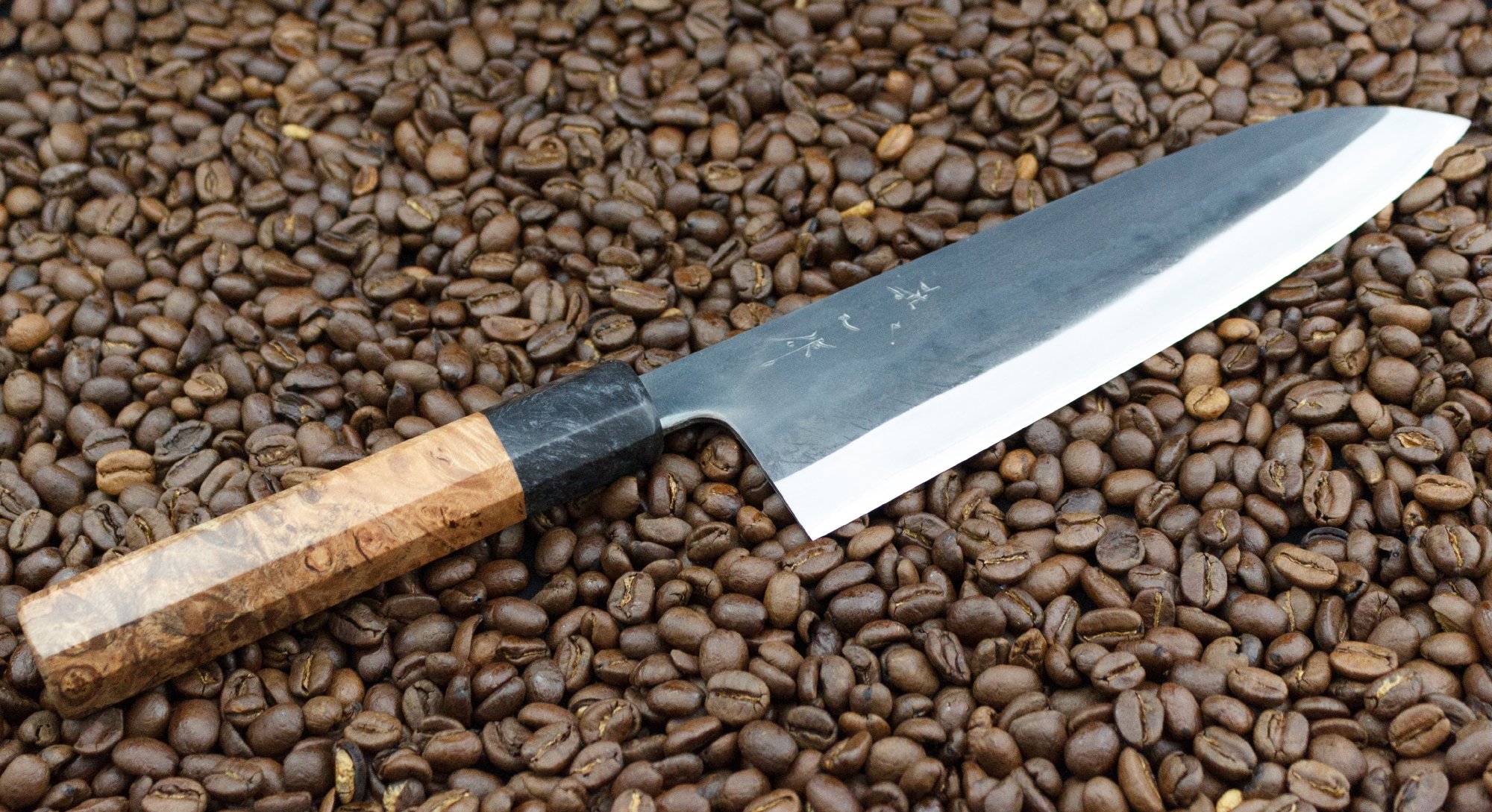
Watanabe
Measurements
The profiles of the knives are not too dissimilar. I would describe them as all-round: all three of them have a proper flat spot (although the Heiji has a slight recurve towards the heel), but they also nicely curve up towards the tip, which makes them suitable for rock chopping. All three knives have nearly the same height at the heel (47 or 48 mm), so they provide enough knuckle clearance.

Profile of the Kochi
They do differ in their spine thicknesses, however. They all have about the same thickness at the heel (4.1 to 4.3 mm), but the Kochi is the only knife with a relatively thin tip: it measures 0.9 mm at one centimeter from the tip. The Heiji and the Watanabe are 1.3 and 1.2 mm thick respectively at the same spot. This makes the Heiji the knife with the thickest tip I own.

Kochi choil shot
Their geometries also differ. At 5 mm above the edge the Heiji, the Kochi and the Watanabe are respectively 0.8, 0.7 and 0.6 mm thick halfway the blade. This may not sound like a large difference, but the thickness of a knife just above the edge is very important for its cutting performance. Again, the Heiji is the thickest knife just above the edge I own (together with a Takeda knife).
The balance point of all three of the knives is well in front of the choil. The Watanabe had it about 2 centimeters in front of the choil, with the Kochi it was about 3 centimeters and with the Heiji it was even half a centimeter more.
Cutting performance
I started my cutting tests with onions. The Watanabe and the Kochi dealt with them beautifully. However, the Heiji had major problems with the horizontal cuts, probably due to its thick tip. One time it even got stuck in an onion. It also did not deal optimally with the vertical cuts.
Then it was time for carrots. Again, the Watanabe and the Kochi cut them fine. I could experience a minimal amount of wedging, but this wasn't enough to bother me. However, the Heiji really made the carrots say crack, a sign of serious wedging.
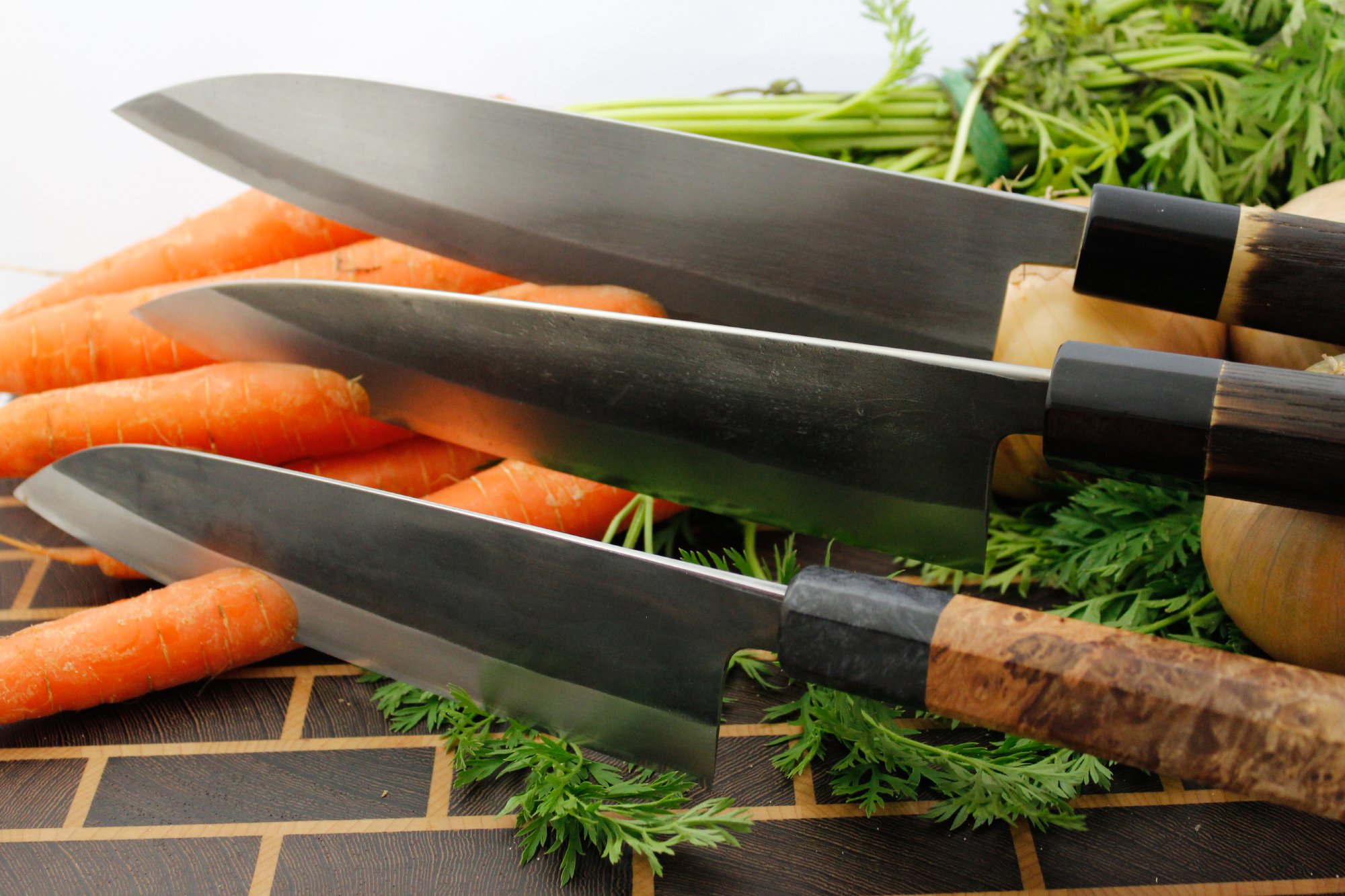
I was making a dish called hotchpotch, a mash of potatoes, onions and carrots, so the final ingredient to deal with was potatoes. All three knives did well on these potatoes, although it was still noticeable that the Heiji was a bit thick behind the edge. Food release on all three of the knives was quite good: better than on the laser type of knives I usually use. It was hard to distinguish the amount of food release of the knives. Maybe it was slightly better on the Heiji, but if it was, this was only by a tiny amount. But food release on all three knives was good.
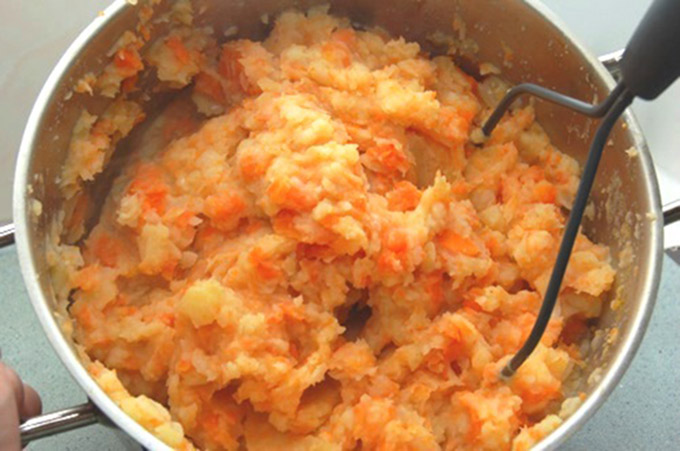
After this I used the knife on many other types of ingredients, of course. Generally they all dealt well with softer foods. But cutting hard foods and making thin slices was the most challenging with the Heiji.
Conclusion
I like workhorse type knives! At least when they are properly ground. They can cut nearly as good as laser-type knives and they have better food release. Ive heard people say their workhorse knife falls through food. That was unfortunately not the case, but I definitely appreciate the fact that they are somewhat blade-heavy.
Of the knives I tested both the Kochi and the Watanabe were very good cutters. I'd say that in this respect they're on par. But the Kochi definitely had the best fit and finish and a thinner tip. The Heiji was too thick above the edge and its tip was too thick for me as well. Ive read many positive stories about the Heiji, but they're hand-made knives and maybe mine was made on a Monday. So Im afraid this one is going to leave my house.
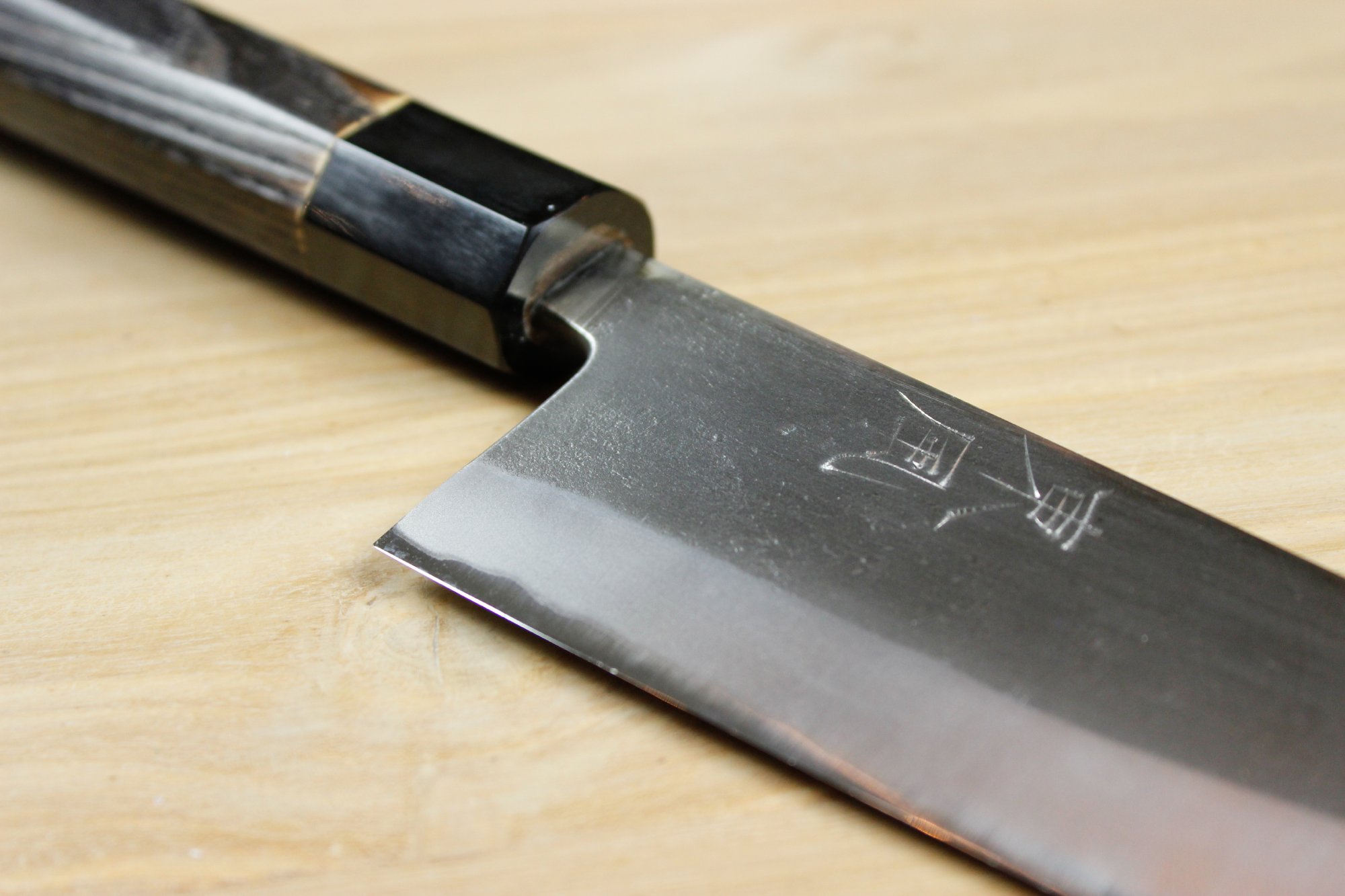
The Kochi: my favorite workhorse knife
Factsheets
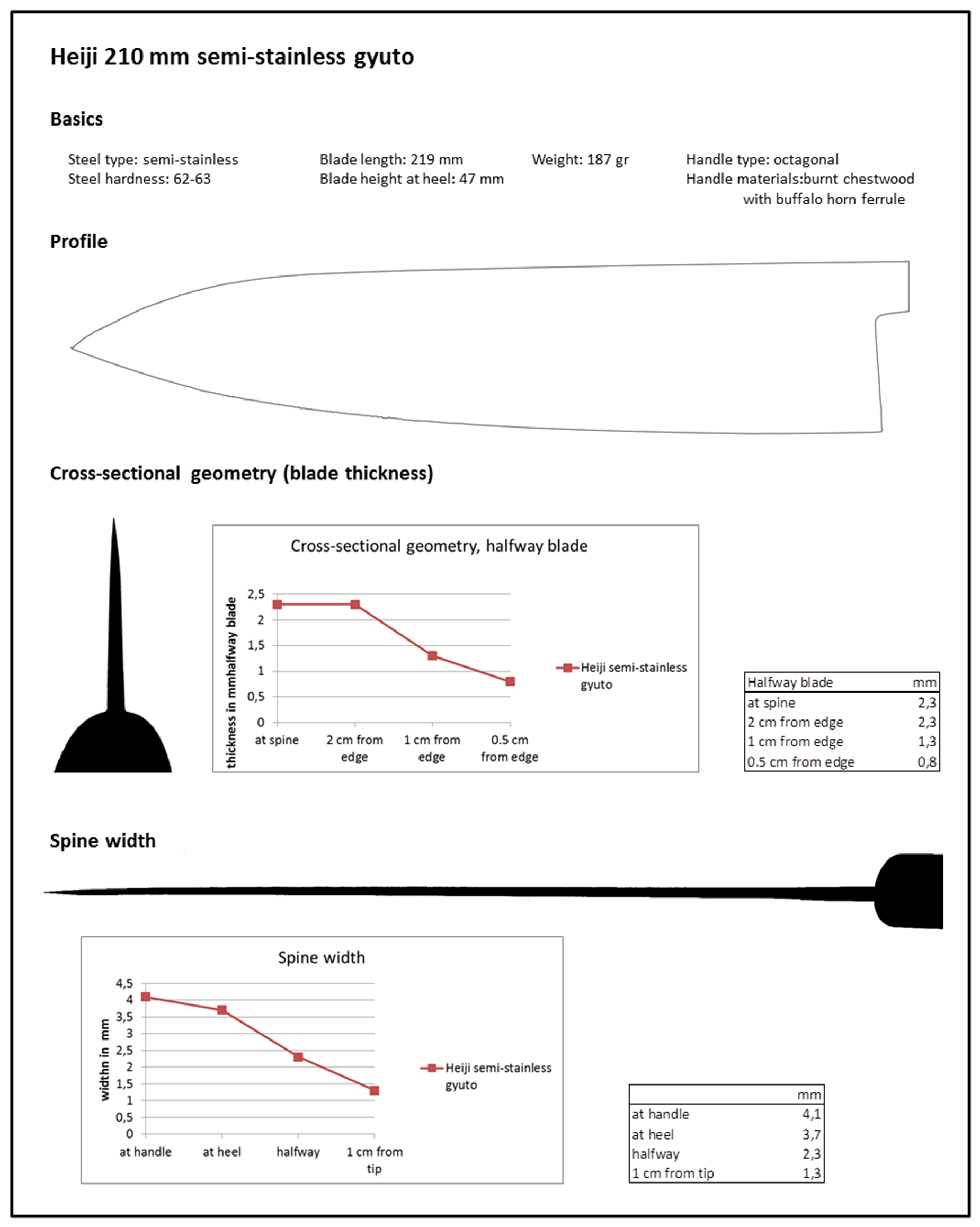
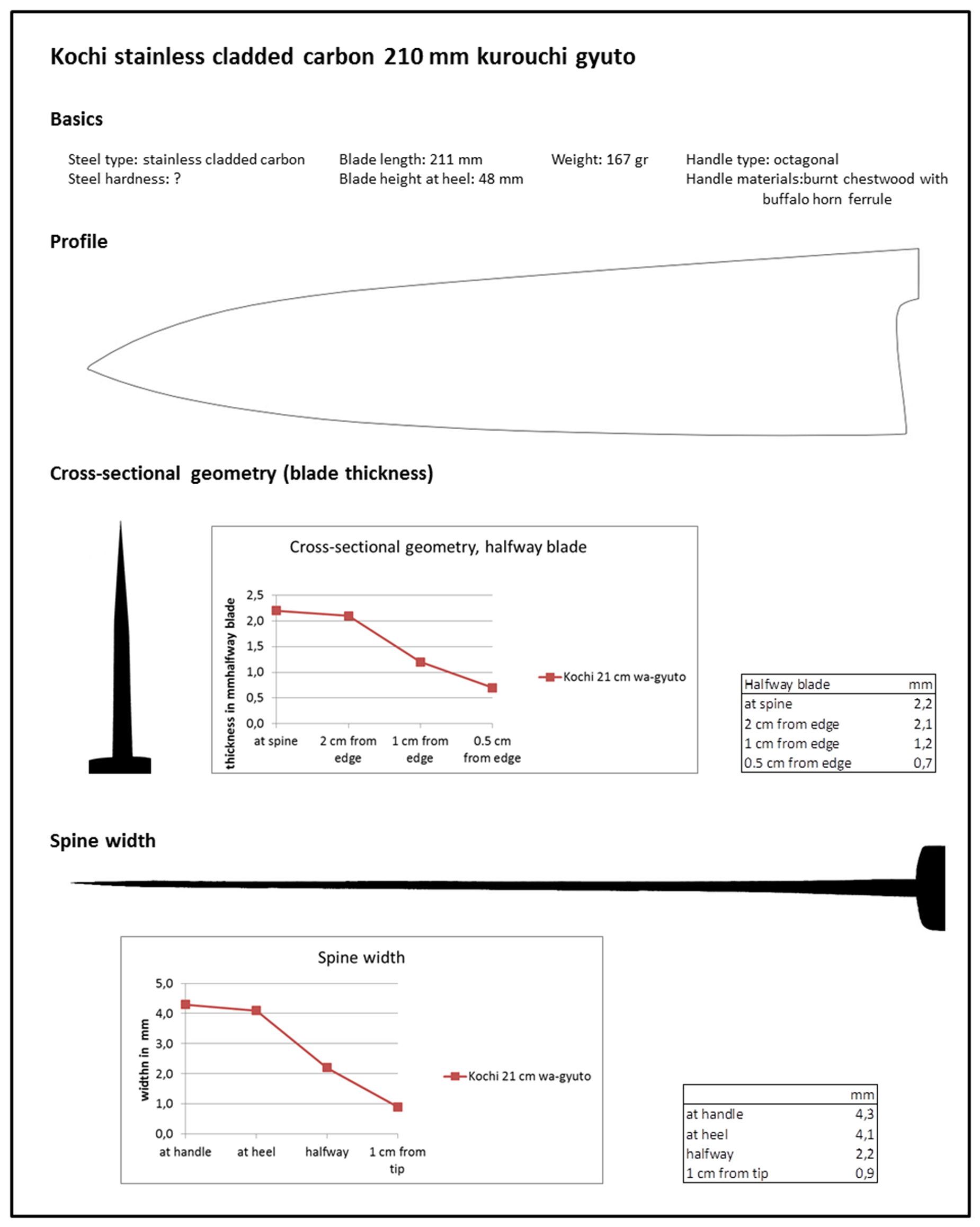
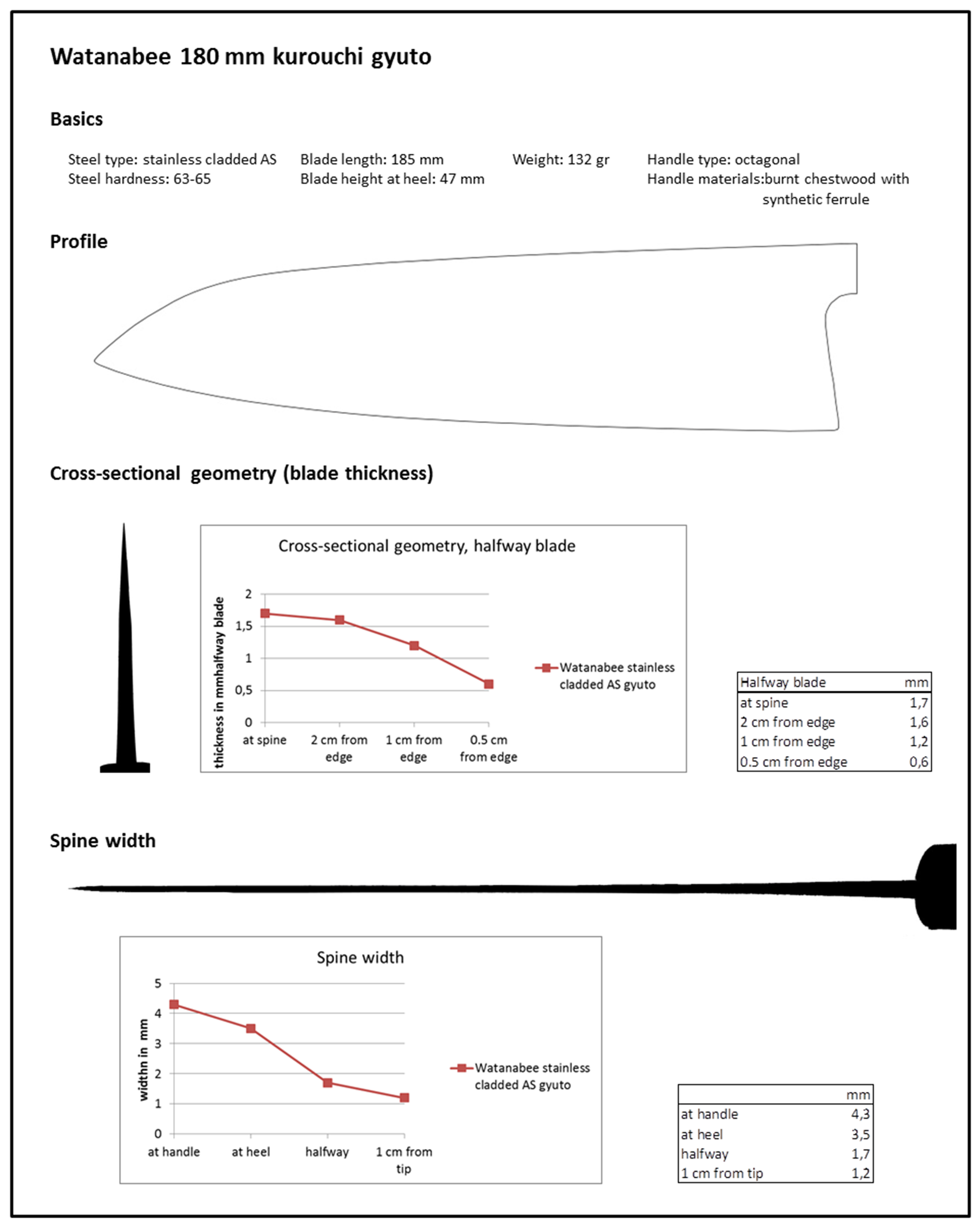
But nowadays there is another type of Japanese knife that is quite popular: the workhorse knife. By a workhorse I mean a knife that is quite hefty (for a Japanese knife) and relatively thick at the spine.

So I decided to get a number of workhorse knives and to see how I liked them: a 210 mm Nakaya-Heiji gyuto, a 180 mm Watanabe gyuto and a 210 mm Kochi gyuto.
Looks
All three of the knives have what I would call a rustic look. The Kochi and the Watanabe have a kurouchi finish and the Heiji is also a cladded knife. The core steel of the Heiji is a semi-stainless steel, the core of the Kochi is an unspecified carbon steel and the Watanabe is made of aogami steel. The claddings on all three of the knives are stainless. Funnily enough, the Heiji was the first one to pick up a patina, even though it was the only one made of semi-stainless steel. None of the knives are very reactive, by the way.

Heiji
Rustic sometimes also means that the fit and finish are not optimal. All three of the knives had handles made of burnt chestwood, but the handle of the Watanabe was badly finished: there was at least a millimeter difference in height between the wood and the ferrule. And the ferrule was made of plastic. So I decided to replace that handle by a nice one made of Oregon maple burl. There were no sharp edges on any of the knife spines, but the Kochi was the only one with a rounded spine and ferrule. It was clearly the best finished knife.

Kochi
All three knives came pretty sharp out of their boxes, only the Heiji had a wire burr. So I first took that one to a fine stone. Even though I hardly sharpened it, I immediately felt I liked the steel: it gave a very good feedback. And I'm sure that if I'd sharpen it further, that would be an easy and enjoyable task.

Watanabe
Measurements
The profiles of the knives are not too dissimilar. I would describe them as all-round: all three of them have a proper flat spot (although the Heiji has a slight recurve towards the heel), but they also nicely curve up towards the tip, which makes them suitable for rock chopping. All three knives have nearly the same height at the heel (47 or 48 mm), so they provide enough knuckle clearance.

Profile of the Kochi
They do differ in their spine thicknesses, however. They all have about the same thickness at the heel (4.1 to 4.3 mm), but the Kochi is the only knife with a relatively thin tip: it measures 0.9 mm at one centimeter from the tip. The Heiji and the Watanabe are 1.3 and 1.2 mm thick respectively at the same spot. This makes the Heiji the knife with the thickest tip I own.

Kochi choil shot
Their geometries also differ. At 5 mm above the edge the Heiji, the Kochi and the Watanabe are respectively 0.8, 0.7 and 0.6 mm thick halfway the blade. This may not sound like a large difference, but the thickness of a knife just above the edge is very important for its cutting performance. Again, the Heiji is the thickest knife just above the edge I own (together with a Takeda knife).
The balance point of all three of the knives is well in front of the choil. The Watanabe had it about 2 centimeters in front of the choil, with the Kochi it was about 3 centimeters and with the Heiji it was even half a centimeter more.
Cutting performance
I started my cutting tests with onions. The Watanabe and the Kochi dealt with them beautifully. However, the Heiji had major problems with the horizontal cuts, probably due to its thick tip. One time it even got stuck in an onion. It also did not deal optimally with the vertical cuts.
Then it was time for carrots. Again, the Watanabe and the Kochi cut them fine. I could experience a minimal amount of wedging, but this wasn't enough to bother me. However, the Heiji really made the carrots say crack, a sign of serious wedging.

I was making a dish called hotchpotch, a mash of potatoes, onions and carrots, so the final ingredient to deal with was potatoes. All three knives did well on these potatoes, although it was still noticeable that the Heiji was a bit thick behind the edge. Food release on all three of the knives was quite good: better than on the laser type of knives I usually use. It was hard to distinguish the amount of food release of the knives. Maybe it was slightly better on the Heiji, but if it was, this was only by a tiny amount. But food release on all three knives was good.

After this I used the knife on many other types of ingredients, of course. Generally they all dealt well with softer foods. But cutting hard foods and making thin slices was the most challenging with the Heiji.
Conclusion
I like workhorse type knives! At least when they are properly ground. They can cut nearly as good as laser-type knives and they have better food release. Ive heard people say their workhorse knife falls through food. That was unfortunately not the case, but I definitely appreciate the fact that they are somewhat blade-heavy.
Of the knives I tested both the Kochi and the Watanabe were very good cutters. I'd say that in this respect they're on par. But the Kochi definitely had the best fit and finish and a thinner tip. The Heiji was too thick above the edge and its tip was too thick for me as well. Ive read many positive stories about the Heiji, but they're hand-made knives and maybe mine was made on a Monday. So Im afraid this one is going to leave my house.

The Kochi: my favorite workhorse knife
Factsheets








